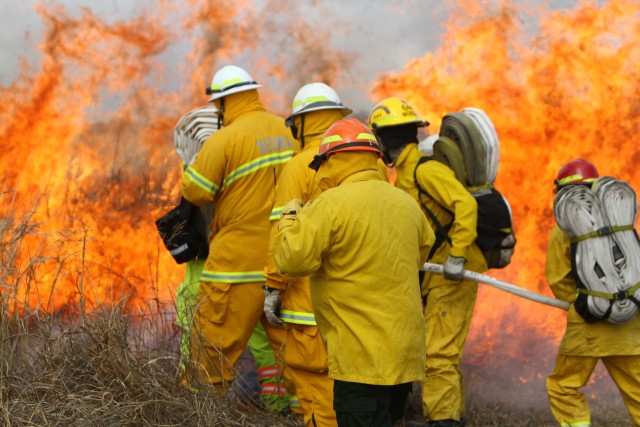
FORT SILL, Okla. -- Sometimes you have to fight fire with fire. That's the strategy about 200 firefighters from Southwestern Oklahoma put into practice Saturday and Sunday as the first Destry Horton Wildland and Emergency Medical Service Regional Fire School was held at Fort Sill.
"It's an opportunity to provide volunteer firefighters in the state training specifically to wildland. We are actually setting live fires and letting them go out and learn basic fire tactical skills, back burn skills, things they can't get anywhere else except in a controlled environment like we have here," said Clint Langford, Fort Sill Fire and Emergency Services assistant fire chief.
The training was named after Destry Horton, a Chickasha firefighter who passed away in 2006 from burns he received while fighting a wildland fire near Duncan.
Lawton's fire department and Oklahoma State University's Fire Service Training planned the training and Fort Sill's Blue Beaver Driving Range provided tall grass sectioned off by various roads serving as fire breaks.
"Grass fires are predictable only by the direction of the wind. If it's a 30 mph wind you end up with a 30 mph head fire," said Langford.
With such a fast moving force the firefighters are taught different techniques to not only extinguish the flames, but also cut off its fuel.
"It's not always a direct attack at the flame," said Jared Williams, Lawton Fire Department training officer. "We may have to get them out ahead of the fire to start constructing fire lines to slow the fire down."
After classroom instruction, it was time to get into the thick of things. An instructor used a drip torch to ignite the already dry vegetation and in seconds the flames leapt more than 6 feet in height with gusts of wind causing it to spread rapidly.
"Grass fires are mobile," said Langford. "They're not stationary so firefighters have to move with the fire to get it under control as quickly as possible before it endangers any structures."
A three-man team suited up in bunker gear from their head to toe quickly went into action spraying water from a hose pack while numerous other firefighters used hand tools to smother any remaining embers and remove any remaining fuel.
"Sometimes you've got to get off the truck and you've got to learn the proper way to go in and actually put out all the hotspots so they don't rekindle," said Colten Leadbetter, Meridian, Okla. Fire Department volunteer.
Leadbetter said every firefighter's role is important, and they constantly have to pay attention so no mistakes are made.
"I wasn't paying attention to hot spot and it almost caught the hose on fire. You really have to keep your head on a 360 and make sure you're doing your job right, and nothing goes wrong."
With high grass, sparse trees and unpredictable weather, Oklahoma's terrain offers a challenge to firefighters. Even in a controlled environment it was evident many are necessary to extinguish a wildland fire.
"You could end up with 10 maybe 15 little fire departments and each one of them having two or three brush rigs or a tanker or pumper. For a big grassfire it takes a lot of people," said Mike Duncan, Oklahoma State University EMS program coordinator.
Duncan said the main focus of their hands-on training was using a progressive hose to reach where a fire truck can't. He also said they learned how to make a proper fire break by digging into the ground and removing any fuel making it at least two and a half times wider than the height of the fuel.
All of those tasks simultaneously mean a lot of manpower which is why different departments often tackle the flames side by side.
"That's the cornerstone of the fire service. If neighbors call, neighbors are there to help," said Williams.
Similar training has been put into practice for years in McAlester, Okla. and Lawton Fire and OSU FST decided it was time to train the western region, reducing property damage and making it safer for firefighters.
"The goal is to give better training to any volunteer or wildland firefighter to prevent injuries and loss of life. That's the mission of the school," said Langford.

Social Sharing